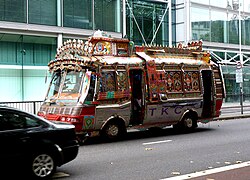
Truck art in South Asia is a popular form of regional decoration, with trucks featuring elaborate floral patterns and calligraphy. [1] [2] It is especially common in Pakistan and India. [3]
Contents
- History and origin
- Practice
- India
- Pakistan
- Influence
- Cars
- Buses
- Fashion
- Print design
- New mediums
- Gallery
- See also
- References
- External links
During the War in Afghanistan, Pakistani decorated trucks that ran services between Pakistan and Afghanistan came to be known as jingle trucks by American troops and contractors who were deployed across the latter country.


























